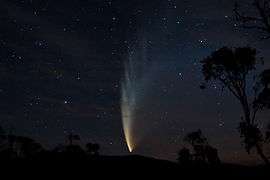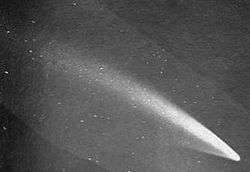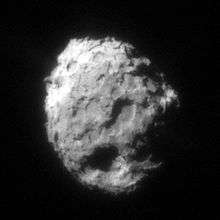Naming of comets

Comets have been observed for the last 2,000 years. During that time, several different systems have been used to assign names to each comet, and as a result many comets have more than one name.
The simplest system names comets after the year in which they were observed (e.g. the Great Comet of 1680). Later a convention arose of using the names of people associated with the discovery (e.g. Comet Hale–Bopp) or the first detailed study (e.g. Halley's Comet) of each comet. During the twentieth century, improvements in technology and dedicated searches led to a massive increase in the number of comet discoveries, which led to the creation of a numeric designation scheme. The original scheme assigned codes in the order that comets passed perihelion (e.g. Comet 1970 II). This scheme operated until 1994, when continued increases in the numbers of comets found each year resulted in the creation of a new scheme. This system, which is still in operation, assigns a code based on the type of orbit and the date of discovery (e.g. C/2012 S1).
Named by year

Before any systematic naming convention was adopted, comets were named in a variety of ways. Prior to the early 20th century, most comets were simply referred to by the year when they appeared e.g. the "Comet of 1702".
Particularly bright comets which came to public attention (i.e. beyond the astronomy community) would be described as the great comet of that year, such as the "Great Comet of 1680" and "Great Comet of 1882". If more than one great comet appeared in a single year, the month would be used for disambiguation e.g. the "Great January comet of 1910". Occasionally other additional adjectives might be used.
Named after people
Possibly the earliest comet to be named after a person was Caesar's Comet in 44 BC, which was so named because it was observed shortly after the assassination of Julius Caesar and was interpreted as a sign of his deification. Later eponymous comets were named after the astronomer(s) who conducted detailed investigations on them, or later those who discovered the comet.
Investigators
After Edmond Halley demonstrated that the comets of 1531, 1607, and 1682 were the same body and successfully predicted its return in 1759, that comet became known as Halley's Comet.[1] Similarly, the second and third known periodic comets, Encke's Comet[2] and Biela's Comet,[3] were named after the astronomers who calculated their orbits rather than their original discoverers. Later, periodic comets were usually named after their discoverers, but comets that had appeared only once continued to be referred to by the year of their apparition.
Discoverers

The first comet to be named after the person who discovered it, rather than the one who calculated its orbit, was Comet Faye – discovered by Hervé Faye in 1843. However, this convention did not become widespread until the early 20th century. It remains common today.
A comet can be named after up to three discoverers, either working together as a team or making independent discoveries (without knowledge of the other investigator's work). For example, Comet Swift–Tuttle was first found by Lewis Swift and then by Horace Parnell Tuttle a few days later; the discoveries were made independently and so both are honoured in the name.
In recent years many comets have been discovered by large teams of astronomers, in this case comets may be named for the collaboration or instrument they used. For example, 160P/LINEAR was discovered by the Lincoln Near-Earth Asteroid Research (LINEAR) team. Comet IRAS–Araki–Alcock was discovered independently by a team using the Infrared Astronomy Satellite (IRAS) and the amateur astronomers Genichi Araki and George Alcock.
In the past, when multiple comets were discovered by the same individual, group of individuals, or team, the comets' names were distinguished by adding a numeral to the discoverers' names (but only for periodic comets); thus Comets Shoemaker–Levy 1 – 9 (discovered by C. Shoemaker, E. Shoemaker & D. Levy). Today, the large numbers of comets discovered by some instruments makes this system impractical, and no attempt is made to ensure that each comet is given a unique name. Instead, the comets' systematic designations are used to avoid confusion.
Systematic designations
Original system
Until 1994, comets were first given a provisional designation consisting of the year of their discovery followed by a lowercase letter indicating its order of discovery in that year (for example, Comet 1969i (Bennett) was the 9th comet discovered in 1969). Once the comet had been observed through perihelion and its orbit had been established, the comet was given a permanent designation of the year of its perihelion, followed by a Roman numeral indicating its order of perihelion passage in that year, so that Comet 1969i became Comet 1970 II (it was the second comet to pass perihelion in 1970)[4]
Current system

Increasing numbers of comet discoveries made this procedure awkward, as did the delay between discovery and perihelion passage before the permanent name could be assigned. As a result, in 1994 the International Astronomical Union approved a new naming system. Comets are now designated by the year of their discovery followed by a letter indicating the half-month of the discovery and a number indicating the order of discovery (a system similar to that already used for asteroids), so that the fourth comet discovered in the second half of February 2006, for example, would be designated 2006 D4. Prefixes are also added to indicate the nature of the comet:
- P/ indicates a periodic comet (defined for these purposes as any comet with an orbital period of less than 200 years or confirmed observations at more than one perihelion passage).[5]
- C/ indicates a non-periodic comet (defined as any comet that is not periodic according to the preceding definition).
- X/ indicates a comet for which no reliable orbit could be calculated (generally, historical comets).
- D/ indicates a periodic comet that has disappeared, broken up, or been lost.[5]
- A/ indicates an object that was mistakenly identified as a comet, but is actually a minor planet.
For example, Comet Hale–Bopp's designation is C/1995 O1. After their second observed perihelion passage, periodic comets are also assigned a number indicating the order of their discovery.[6] So Halley's Comet, the first comet identified as periodic, has the systematic designation 1P/1682 Q1. Comets that first received a minor planet designation keep the latter, which leads to some odd names such as P/2004 EW38 (Catalina–LINEAR).
There are only seven bodies in our Solar System that are cross-listed as both comets and asteroids: 2060 Chiron (95P/Chiron), 4015 Wilson–Harrington (107P/Wilson–Harrington), 7968 Elst–Pizarro (133P/Elst–Pizarro), 60558 Echeclus (174P/Echeclus), 118401 LINEAR (176P/LINEAR), 323137 2003 BM80 (282P/2003 BM80) and 300163 2006 VW139 (288P/2006 VW139).
References
- ↑ Ridpath, Ian (3 July 2008). "Halley and his Comet". A brief history of Halley's Comet. Retrieved 14 August 2013.
- ↑ Kronk, Gary W. "2P/Encke". Gary W. Kronk's Cometography. Retrieved 14 August 2013.
- ↑ Kronk, Gary W. "3D/Biela". Gary W. Kronk's Cometography. Retrieved 14 August 2013.
- ↑ Arnett, B. (14 January 2000). " 'Official' Astronomical Names". International Astronomical Union. Retrieved 2006-03-05.
- 1 2 "Cometary Designation System". Minor Planet Center. Retrieved 2011-07-03.
- ↑ "Cometary Designation System". Committee on Small Body Nomenclature. 1994. Retrieved 2010-08-24.

